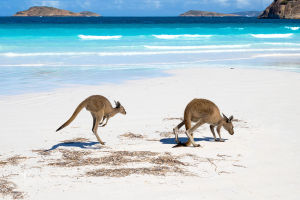The Scarlet Macaw (Ara macao) is one of the most strikingly colorful and iconic birds in the world. Known for its vivid red, blue, and yellow plumage, this large parrot species inhabits the rainforests of Central and South America.
Apart from their stunning appearance, Scarlet Macaws are also recognized for their intelligence, social behavior, and long lifespan, making them a marvel of the avian world.
Physical Description
The Scarlet Macaw is a large bird, typically measuring around 81-96 cm (32-38 inches) in length, with an impressive wingspan of over 1 meter (3.3 feet). The majority of its feathers are a bright, scarlet red, while its wings boast an eye-catching blend of yellow and blue. This dazzling coloration helps the macaw stand out among other rainforest species, though it also serves as excellent camouflage in the vibrant tropical environment.
Habitat and Range
Scarlet Macaws are native to the humid, evergreen rainforests of Central and South America, from southern Mexico to Brazil, including countries such as Guatemala, Colombia, and Peru. These birds are commonly found in the canopy of rainforests, preferring areas near rivers and wetlands.
Behavior and Social Structure
Scarlet Macaws are highly social birds, often found in pairs or small family groups. They are monogamous creatures, forming lifelong bonds with their mates. In the wild, macaws are known to form flocks, which can be seen flying together in vibrant, synchronized patterns. These birds are also known for their loud, raucous calls, which they use to communicate across long distances in the dense forest.
Diet
Scarlet Macaws are primarily frugivorous, feeding on a variety of fruits, nuts, and seeds. They are known to consume foods that are toxic to other animals, using their strong beaks to crack open hard shells and access the nutritious contents inside. Interestingly, macaws are often seen visiting clay licks, where they consume mineral-rich clay, which is believed to neutralize toxins in their diet.
Lifespan and Reproduction
Scarlet Macaws are long-lived birds, with a lifespan of up to 50 years in the wild and even longer in captivity, where they can live up to 70 years or more. This long lifespan is unusual for birds of their size and contributes to their status as enduring symbols of the rainforest.
Conservation Status
The Scarlet Macaw is currently listed as "Least Concern" by the International Union for Conservation of Nature (IUCN), but its population is declining. Habitat destruction, illegal logging, and the pet trade are significant threats to these beautiful birds. Conservation programs, such as protected reserves and breeding initiatives, are essential to safeguard the future of the Scarlet Macaw.
Fun Facts About Scarlet Macaws
Incredible Flyers: Scarlet Macaws can fly at speeds of up to 35 miles per hour (56 km/h), making them agile in their forest habitat.
Mimicry: Like other parrot species, Scarlet Macaws can learn to mimic sounds, including human speech, when kept in captivity.
Lifelong Bond: Macaws are known to form lifelong bonds with their mates, often staying together for many years.
Bright Beak: Their powerful beaks can exert incredible pressure, enough to crack open the toughest nuts.
Cultural Significance: Scarlet Macaws have been revered by many indigenous cultures, particularly the Mayans, who saw them as symbols of the sun.
The Scarlet Macaw is a true symbol of the tropical rainforest, representing the beauty and diversity of the natural world. With its striking colors, intelligent behavior, and strong social bonds, this bird captivates all who encounter it. So, Lykkers, conservation efforts are crucial to ensuring that future generations continue to marvel at this vibrant species, both in the wild and in the cultural landscapes of Central and South America.


